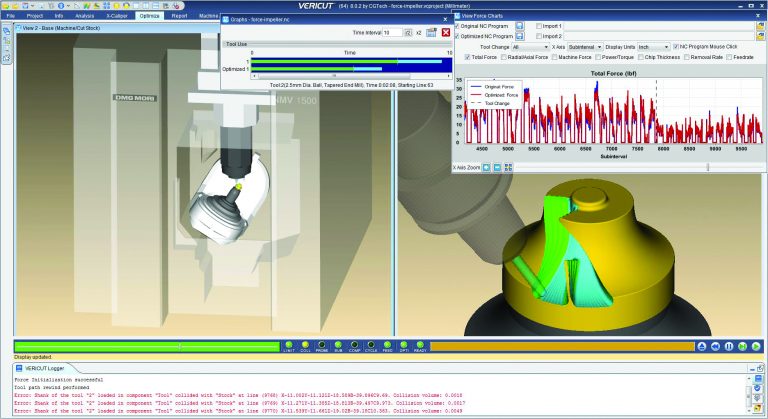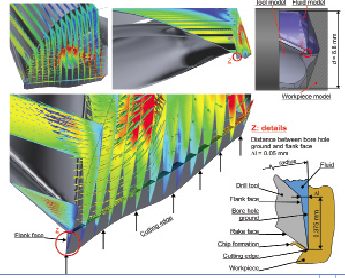原文链接:https://www.sme.org/simulating-is-believing
Simulation tools are making it much easier for manufacturers to optimize their processes, visualizing the entire path of production from NC metalcutting simulations through 3D design and factory-floor imaging. With today’s simulation tools, toolpath designers and manufacturing engineers can easily see exactly where NC toolpaths will crash and be able to fix situations on the fly, leading to immensely speeding up simulation and verification of the metalcutting process.
Some of the latest twists in simulation systems feature new capabilities that are being applied to the burgeoning additive manufacturing processes that builders are embracing for rapid prototyping and additive manufacturing of production components. New NC simulation software is being adapted to accommodate these additive processes, making it much simpler to calculate and simulate the time required to build parts in additive’s layer-by-layer processes for both prototyping and to build production metal parts.
In more traditional subtractive machining, manufacturers are also continuing to focus on an ongoing trend toward spreading the wealth with higher-end simulation tools, with “democratizing” and spreading the use of simulation including computer-aided engineering (CAE), typically used mainly by highly trained specialists, throughout the manufacturing design/production chain.
Simulating for Additive and Subtractive

The latest NC simulation and verification tools including Vericut from CGTech (Irvine, CA) and NCSimul from Spring Technologies (Boston) are adding additive capabilities to simulate and verify processes in much the same way as they do for traditional machining.
“Additive manufacturing is the latest trend, with more and more manufacturers incorporating this method into their catalog of capabilities,” said Gene Granata, CGTech product manager for Vericut. “CGTech is currently working with technology partners such as GE, Dassault Aviation, Mazak, The University of Sheffield, and Connecticut Center for Advanced Technology [CCAT] to collaborate and cultivate our AM module slated to be released in Vericut 8.1, due out later this year.”
The new Vericut adds optimized toolpaths using data downloaded from the cloud. “With our latest Vericut software release 8.0.2, we have updated our Force ‘physics-based’ toolpath optimization module, which now receives input values directly from cloud-based tooling and benefits from several new features that streamline optimization setup,” Granata noted. “By micro-analyzing the cutting conditions encountered by an NC program, Force ensures NC programs have optimal feed rates and ideal chip thicknesses that do not exceed safe force or power limits. This improves productivity immensely.”
Technical improvements in the new Vericut include more than 100 user requests in Vericut 8.0.2 that streamline set up and improve user experiences, helping extend the life of tools, and avoiding costly machine spindle damage. “Some specific improvements include updates within the Force optimization module, Tool Manager now imports more available data about tool usage and performance, and the Vericut Drill and Fastener [VDAF] Simulation product benefits from an updated graphical user interface [GUI],” Granata added. “All of these enhancements are designed to help our customers verify and optimize their NC code as efficiently as possible.”

While simulating for additive is relatively new, it shows great promise for manufacturing customers, noted Silvere Proisy, general manager, Spring Technologies, developer of NCSimul Machine and related simulation offerings. “For additive, we are simulating the motion of the machines and calculating the time needed for layering the metal,” Proisy said.
Spring Technologies has concentrated mostly on metal additive manufacturing processes, Proisy noted, working with Tier 1 and Tier 2 suppliers in the aerospace/defense sector including builders of engines and landing gear that develop simulations to leverage capabilities within the company’s NCSimul software for these additive processes.
Simulation of any manufacturing process is critical, and with Spring’s NCSimul 4CAM software, manufacturing operations get great flexibility on the shop floor, Proisy said. One of the advantages of NCSimul is that users can simulate the manufacturing cutting or additive process in actual G code, Proisy said, and if there are cuts or moves that shouldn’t be made, it’s easy to go back and rebuild the process. “You don’t have to restart the process, you can edit the simulation ‘on the fly’ and that allows you to rebuild the part,” he said.
Other simulation software suppliers getting into the additive game include software heavyweights Dassault Systèmes (Paris) and Siemens PLM Software (Plano, TX).
Dassault’s entry into the AM arena include the company’s Additive Manufacturing Engineer, available in both cloud and on-premises versions, that enables manufacturers to prepare and validate AM processes. The software saves users time by enabling archiving best practices for reuse, automatically optimizing part positions, and developing different strategies for the additive process.
The 3DExperience 2017x release is said to transform design, simulation and manufacturing with a much higher level of integration. With the new Function Generative Designer role, designers provide the functional specification (including the 3D envelope, the loading scenario, materials, weight reduction targets, desired manufacturing process), and a push of the button runs a simulation and generates the optimized concept shape. This allows designers and engineers to take advantage of the flexibility of additive manufacturing, compared to more traditional manufacturing processes such as milling, casting and forging. Two new digital manufacturing and production roles for additive manufacturing define and optimize the setup and process for powder bed fusion and industrial 3D printing, and to program the laser path.
In January 2017, Siemens AG (Munich) and additive developer Materialise NV (Leuven, Belgium) announced a partnership under which the companies would collaborate on integrating Siemens PLM’s NX software with Materialise’s technologies in the AM sector. Under the agreement, the companies integrated Materialise technology into NX CAD/CAM/CAE software, enabling it to accurately design CAD models for powder bed fusion and material-jetting 3D printing processes. The resulting software is said to speed up the process of building fully 3D-printed parts by 30% or more, according to the companies.
The deal represents a huge leap forward in making additive manufacturing a mainstream production practice for customers, said Zvi Feuer, senior vice president of Manufacturing Engineering Software for Siemens PLM Software, in a statement. “Until now, the additive manufacturing process required manufacturers to work with two separate systems—one for product design, and another to prepare that design for 3D printing,” Feuer said. “The data translation issues and lack of associativity between these two systems created a process that was time-consuming and subject to errors. By eliminating these issues, we are helping to expand the adoption of additive manufacturing as a universally accepted production tool.”
NX now leverages technology from the Materialise Magics 3D Print Suite, enabling commonly-adopted AM processes for end-part manufacturing, including powder bed fusion, as well as material jetting, that promise to further accelerate AM’s evolution from a prototyping to a full-scale manufacturing technology. The solution seamlessly and associatively links NX with Materialise lattice technology, support structures design, 3D nesting, build tray preparation, and build processors framework technology for additive manufacturing. This eliminates data translation, conversions and ensures that changes to digital product design models are automatically and associatively reflected in the 3D print jobs. The result is greater model accuracy, higher quality, and a much faster design to production process.
Sharing CAE with the Masses
Among the latest simulation trends, wider adoption of CAE tools—including tools such as computational fluid dynamics (CFD), finite element analysis (FEA), and topology optimization—has begun to make some headway into manufacturing operations, as more engineers outside of CAE specialists leverage the power of these simulation technologies.
“Some of the trends affecting manufacturing overall are also reflected in simulation software. These include additive manufacturing and related simulation techniques, topology optimization, and simulation of composites on the product side,” noted Ravi Shankar, director, global simulation product marketing, Siemens PLM Software. “Additive manufacturing also has implications for the creation of tooling for various traditional manufacturing processes. Additionally, simulation techniques are also applied towards the manufacturing process such as assembly simulation, robotics simulation, material flow simulation, and human simulation and ergonomics.”
Simulation enables much earlier detection of potential problems and enables companies to avoid such problems before they occur, Shankar noted. “This directly impacts productivity by decreasing manufacturing downtime, by enabling faster processing, by increasing tool life and usage, and by reducing material costs,” he said.
The digitalization process is essential to making a good additively manufactured product, Shankar added. “Siemens has several initiatives to streamline the design, simulation, and production for additive products,” he said. “These include recent innovations for generative design, which enables designers using NX to use topology optimization techniques to create lightweight, organic shapes, refine these designs using Convergent Modeling, and then drive the manufacturing processes. Similarly, for composites, Siemens offers solutions for optimizing composite layups, simulating the draping process and the impact on the parts, simulating curing and spring back effects, etc.”
While there’s been progress in the “democratization” of CAE tools, as described by CAD/CAM researcher CIMdata Inc. (Ann Arbor, MI) a few years ago in its simulation research, there is quite a long way to go in furthering adoption of such simulations, according to Shankar. “We certainly see some companies leading the way in terms of adoption of simulation technologies, but we also see a lot of potential to expand usage and bring the value of these technologies to the manufacturing engineer,” Shankar added. “Simulation technologies are being used for structural analysis, simulation of mold flow and cooling, composites manufacturing and others. In most cases, these are still being performed by dedicated simulation specialists. So it is our belief that the democratization of CAE, while underway, has yet to reach its full potential.”
Optimized Drilling
Machining expensive corrosion-resistant materials is extremely hard on drills, and a recent study by researchers at the Technical University of Dortmund (Dortmund, Germany) used fluid flow and structural analysis tools from Ansys Inc. (Pittsburgh) to analyze process coolant flow distribution and achieve longer tool life.
At the Technical University of Dortmund’s Institute of Machining Technology (ISF), a research team led by Professor Dirk Biermann analyzed methods to extend the life of drills for use on the superalloy Inconel 718. The low thermal conductivity of this alloy means that a large amount of heat must be transported away from the boring zone using external methods, or the tool can become deformed. This can lead to poor bore quality or breakage of the carbide drill bit. Relatively low drill speeds under 50 m/min are used to keep temperatures lower in the cutting zone, but a liquid coolant is still required. To direct the coolant fluid where it is needed, it is pumped through two tiny channels inside the land, the solid, helical pattern of the drill bit.
To understand the complex interaction between the drill structure, the coolant fluid and the Inconel workpiece, the ISF team used simulation tools from Ansys for process optimization by performing a fluid–structure interaction (FSI) analysis. The process included creating completed fluid meshes, then the engineers used Ansys CFX computational fluid dynamics (CFD) software to model the distribution of coolant through the fluid domain. The team also used Ansys Mechanical with an added boundary condition of the coolant forces calculated by CFX to complete the FSI analysis. Including all of the different CFD and Mechanical simulations, ISF completed its computational analysis within four weeks. “Drilling into an Inconel alloy is carefully managed to prevent rapid wear and damage to the machine tools,” noted Biermann. “The team modified its cooling process to improve the tool life by about 50%.”
Validating the Digital Factory

Aside from additive and CAE developments, the need for manufacturers to quickly design factory-floor layouts has never been greater. New digital manufacturing simulation tools like the Fastsuite Edition 2 from Cenit North America (Auburn Hills, MI) help manufactures design factory layouts and validate all manufacturing processes in advance, speeding the process and optimizing designs.
“IoT or Industry 4.0 represents the radical change that’s shaking the very foundations of the manufacturing floor. Digital factory software and 3D tools are driving that change forward,” noted Lee Van Every, Cenit North America senior account manager. “The digital factory software helps companies efficiently break into smart manufacturing. Nowadays, the software must be compatible with all CAD systems and work with any manufacturer’s robots and machines. This is a mandatory prerequisite for customer relationships that are becoming more and more diverse with more complex and demanding systems.”
Today’s 3D-based simulation software allows visualization and validation of processes and production tasks, Van Every noted. “Production plants are seldom established from scratch, but are often re-planned while production is running. Having the virtual factories and model plants as an exact representation of the real production systems, not just geometrically and kinematically, but also in regard to the logical behavior and control of the manufacturing units, guarantees agile, self-organized production units,” he said.
“Digital factory allows implementation of new manufacturing processes, plant concepts, and technologies that would be too expensive or even impossible without simulation-based solutions,” he added. “The more robotic applications are used—not only for simple handling tasks, but also for complex production steps—the greater the advantage of using programming and simulation tools. Software solutions are leading the way to these complex applications, giving the operator the necessary programming and simulation environment to make applications that were previously represented through a manual teach-in or would not show the necessary process quality.
Instead of building a quick layout with 3D CAD components from the catalog, and then programming the scripts and macros for simulating the material flow and behavior of the cell, FastSuite Edition 2 uses the mechatronic components and resources for the layout definition and at the same time is defining a schematic logic for the production island, according to Van Every. “In this way, it is ensured that the simulated and real behavior match—because the simulation is based on the same logic used during the PLC programming and therefore corresponds to the real system behavior later on.”
Cenit’s new FastSuite software provides user-friendly functions for integrating new, project-specific components in the layout, Van Every said. “This process must be quick and easy for users without programming knowledge to complete.”
The software infrastructure is based on open standards, he added, with consistent use of AML (Automation Markup Language) as a descriptive language for system models, for example, which Van Every said allows considerably simpler interaction with engineering partners through standardized, system-neutral exchange of complete system data or equipment data, including kinematic and logic definitions. In addition, PLC Open ensures that the system logic at the basis of the first simulation concepts can also be used for later PLC programming. The software uses a shared memory in which the controls write the simulation data and from which the 3D visualization then reads the simulation data.
“Production processes like roll hemming, sealing, adhesion or painting require a virtual programming and simulation environment, so that they can also be efficiently operated when small batches come through or engineering changes take place, requiring an update of new offline programs for the robot cells,” Van Every stated. “Then there is another aspect that shows the advantage of a modern digital factory: It is far more efficient to re-use not only the CAD data, but also the metadata provided by engineering [such as for fasteners] instead of redefining them in production every time.”
On the production side, Line Designer is an advanced application to design and visualize layouts of production lines in NX software, Siemens’ Shankar said. “The integrated Siemens PLM Software platform enables engineers to easily associate the designed layout to manufacturing planning. So the layout designed with Line Designer can be used to validate the manufacturing process using Tecnomatix software for digital manufacturing. Using the Process Simulate application, you can validate a wide range of robotic applications, allowing you to simulate complete production systems, including cell validation and robot placement optimization. By simulating production processes, you can define the optimum manufacturing process.”







 苏公网安备 32059002003696号
苏公网安备 32059002003696号